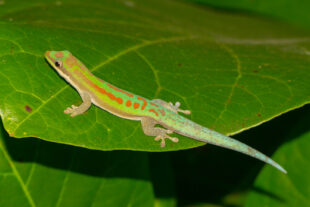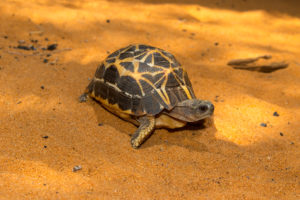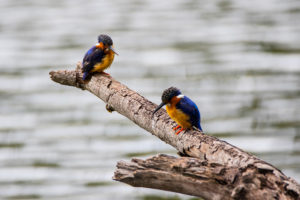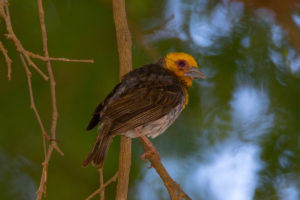Berenty:
The name of the reserve means ‘many eels’, alluding to the once abundant fishing grounds of the Mandrare River. Berenty is one of the most visited protected areas in Madagascar.
Location:
The Berenty reserve is located 82 kilometres west of the coastal town of Tolagnaro (French: Fort Dauphin) in the far south of Madagascar. From Tolagnaro, Berenty can be reached in two to three hours by off-road vehicle via the RN13. In Amboasary Sud, about 10 kilometres from Berenty, the road turns off onto a side road. It takes three days to get to Tolagnaro by car from the capital Antananarivo, but the last few hundred kilometres are practically off-road and, depending on the time of year, difficult to predict. Domestic flights directly from Antananarivo to Tolagnaro are more practical and save time. Taxibrousse are not recommended, especially in the south of Madagascar.
Information about the protected area:
The Berenty Reserve has a relatively small area of only 2 km², which includes spiny forest, gallery forest and savannahs. The entire reserve is surrounded by sisal plantations.
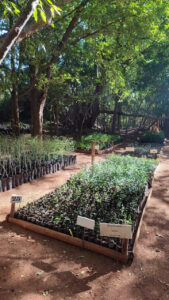
After the Second World War, Marthe de Heaulme worked as Sister Gabrielle in a small social centre of the Sisters of Mercy order in Amboasary Sud. Her brother Henry de Heaulme also emigrated from La Réunion to Madagascar and acquired a plantation near Toamasina on the east coast. Several years later, in 1936 to be precise, Henry de Heaulme and his brother Alain acquired a 10 km² concession near the Mandrare River from the French occupying power in Madagascar. Some of the land was soon cleared for sisal plantations, but the largest contiguous forest area was left untouched. This later became today’s Berenty Reserve. Henry de Heaulme lived on site for many years with his wife Marcelle Bellier de Villentroy.
In 1963, the American primatologist Alison Jolly was the first to discover the Berenty reserve, which was not yet open to travellers at the time, for scientific studies. She researched the reserve’s ring-tailed lemurs and, with a large number of publications, ensured that Berenty is still a popular object of study today and that ring-tailed lemurs are among Madagascar’s best-researched lemurs. However, it was not until the 1980s that Berenty was opened to private travellers – and promptly became a magnet for visitors. The anthropologists Georges Heurtebize and Sara Fee finally founded a small museum about the Antandroy tribe living in the area. Today, Berenty is privately owned by Didier Foulon and Claire de Heaulme-Foulon.
Climate:
The south of Madagascar is very warm and dry all year round, with temperatures above 30°C being the norm. During the relatively long dry season from the end of March to October, it gets very cool at night with temperatures plummeting to over 20°C. During the rainy season, it is very humid and consistently warm. Long clothing and plenty of sun cream as well as a good amount of water should therefore always be part of your basic equipment in Berenty.
Infrastructure:
The reserve itself has twelve upscale bungalows with showers, toilets and running water. Electricity is generated via solar panels and is therefore only available early in the morning and in the evening. A very good restaurant provides travellers with tasty meals. There is no other accommodation or major shopping facilities directly on site. Four rustic, small accommodations with cooking facilities and sanitary facilities are available free of charge on request for scientists working on site. The small Antandroy museum is still open today. A folkloric dance group from the neighbouring village is happy to give demonstrations of their art for a small fee.
The paths through the reserve are all very wide, flat and therefore easy to walk on. During the dry season, the laterite is like fine dust. During the rainy season, the reserve is sometimes not open.
Flora and Fauna:
The Berenty reserve is famous for its ‘dancing’ white Verreaux’ Sifakas on the bright orange-red laterite soil. But it’s not just Verreaux’ Sifakas that can be observed here, several groups of ring-tailed lemurs also live on the grounds. They are also quite famous – if you see troups of ring-tailed lemurs with their characteristic curled tails run on the red ground in films – that’s definitely Berenty! The lemurs are used to humans and come very close. Red-fronted and collared lemurs are also found in Berenty, but they were introduced here by humans. Mouse lemurs (Microcebus murinus and M. griseorufus) and sportive lemurs (Lepilemur leucopus) can be seen at night. Berenty is also home to the largest colony of flying foxes (Pteropus rufus) in southern Madagascar. At its peak, it is said to have consisted of 1800 animals. Today there are only a few hundred left, but even that is impressive.
Reptile lovers will find some treasures of the south in Berenty: both the Radiated Tortoise and the Spider Tortoise are native to the area. Warty chameleons (Furcifer verrucosus) sit in the finely branched branches of the thorn forest, and if you look closely, you can spot some day geckos or collared lizards. The Madagascar tree boa (Sanzinia volontany) and the southern Madagascar boa can also be found here, as can Geay’s hognosed snake (Leioheterodon geayi). Some tortoises and Nile crocodiles can still be admired in enclosures within the reserve. The last wild Nile crocodile on the banks of the Mandrare was seen in 1992.
During the breeding season, Berenty is also the right place for birdwatchers. Over a hundred bird species live in the small reserve, most of them being endemic. Giant and crested Coua, Madagascar Nightjar and Hook-billed Vanga (Vanga curvirostris) can regularly be observed here. The paradise flycatcher, bee-eaters, broad-billed rollers and grey-headed love birds are among the frequent feathered inhabitants of the reserve. And if you go on a short safari on foot at night, you may catch a glimpse of the pretty Madagascar owl (Athene superciliaris) or the Torotoroka scops owl.
 MADAMAGAZINE Your Magazine about Madagascar
MADAMAGAZINE Your Magazine about Madagascar













